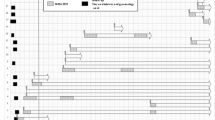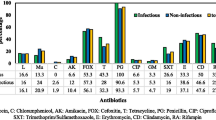Abstract
The purpose of this investigation was to determine the prevalence of community-associated meticillin-resistant Staphylococcus aureus (CA-MRSA) and Panton–Valentine leucocidin (PVL)-positive S. aureus in general practice (GP) patients with skin and soft tissue infections (SSTI) in the northern (Groningen and Drenthe) and southern (Limburg) regions of The Netherlands. Secondary objectives were to assess the possible risk factors for patients with SSTI caused by S. aureus and PVL-positive S. aureus using a questionnaire-based survey. From 2007 to 2008, wound and nose cultures were obtained from patients with SSTI in general practice. These swabs were analysed for the presence of S. aureus and the antibiotic susceptibility was determined. The presence of the PVL toxin gene was determined by polymerase chain reaction (PCR) and the genetic background with the use of spa typing. A survey was performed to detect risk factors for S. aureus infection and for the presence of PVL toxin.S. aureus was isolated from 219 out of 314 (70%) patients with SSTI, of which two (0.9%) patients were MRSA-positive. In 25 (11%) patients, the PVL toxin gene was found. A higher prevalence of PVL-positive S. aureus of patients with SSTI was found in the northern region compared to the south (p < 0.05). Regional differences were found in the spa types of PVL-positive S. aureus isolates, and for PVL-negative S. aureus isolates, the genetic background was similar in both regions. The prevalence of CA-MRSA in GP patients with SSTI in The Netherlands is low. Regional differences were found in the prevalence of PVL-positive S. aureus isolates from GP patients with SSTI. Household contacts having similar symptoms were found to be a risk factor for SSTI with S. aureus.

Similar content being viewed by others
References
Moran GJ, Krishnadasan A, Gorwitz RJ et al (2006) Methicillin-resistant S. aureus infections among patients in the emergency department. New Engl J Med 355:666–674
Gillet Y, Issartel B, Vanhems P et al (2002) Association between Staphylococcus aureus strains carrying gene for Panton–Valentine leukocidin and highly lethal necrotising pneumonia in young immunocompetent patients. Lancet 359:753–759
Lina G, Piémont Y, Godail-Gamot F et al (1999) Involvement of Panton–Valentine leukocidin-producing Staphylococcus aureus in primary skin infections and pneumonia. Clin Infect Dis 29:1128–1132
Woodin AM (1960) Purification of the two components of leucocidin from Staphylococcus aureus. Biochem J 75:158–165
Kuehnert MJ, Kruszon-Moran D, Hill HA et al (2006) Prevalence of Staphylococcus aureus nasal colonization in the United States, 2001–2002. J Infect Dis 193:172–179
Dufour P, Gillet Y, Bes M et al (2002) Community-acquired methicillin-resistant Staphylococcus aureus infections in France: emergence of a single clone that produces Panton–Valentine leukocidin. Clin Infect Dis 35(7):819–824
SWAB. NethMap 2010. Consumption of antimicrobial agents and antimicrobial resistance among medically important bacteria in the Netherlands. http://www.swab.nl/swab/cms3.nsf/uploads/6F9140D61805A468C12577530037D22B/$FILE/Nethmap_2010_def.pdf. Accessed 16 Dec 2010
EARSS Annual Report 2008. On-going surveillance of S. pneumoniae, S. aureus, E. coli, E. faecium, E. faecalis, K. pneumoniae, P. aeruginosa. The EARSS Management Team, members of the Advisory Board, and national representatives of EARSS, Bilthoven, The Netherlands, October 2009
Grundmann H, Aanensen DM, van den Wijngaard CC, European Staphylococcal Reference Laboratory Working Group et al (2010) Geographic distribution of Staphylococcus aureus causing invasive infections in Europe: a molecular-epidemiological analysis. PLoS Med 7(1):e1000215
Otter JA, French GL (2010) Molecular epidemiology of community-associated meticillin-resistant Staphylococcus aureus in Europe. Lancet Infect Dis 10(4):227–239
Stam-Bolink EM, Mithoe D, Baas WH et al (2007) Spread of a methicillin-resistant Staphylococcus aureus ST80 strain in the community of the northern Netherlands. Eur J Clin Microbiol Infect Dis 26:723–727
Wannet WJ, Heck ME, Pluister GN et al (2004) Panton–Valentine leukocidin positive MRSA in 2003: the Dutch situation. Euro Surveill 9(11):28–29
Wannet WJ, Spalburg E, Heck ME et al (2005) Emergence of virulent methicillin-resistant Staphylococcus aureus strains carrying Panton–Valentine leucocidin genes in The Netherlands. J Clin Microbiol 43(7):3341–3345
Deurenberg RH, Stobberingh EE (2008) The evolution of Staphylococcus aureus. Infect Genet Evol 8(6):747–763, Epub 2008 Jul 29
The International Classification of Primary Care ICPC-2-R, Revised second edition, WONCA International Classification Committee, Oxford University Press 2005
Fridkin SK, Hageman JC, Morrison M, Active Bacterial Core Surveillance Program of the Emerging Infections Program Network et al (2005) Methicillin-resistant Staphylococcus aureus disease in three communities. N Engl J Med 352(14):1436–1444
Isenberg HD (1998) Essential procedures for clinical microbiology. ASM Press, Washington, DC
Clinical and Laboratory Standards Institute (CLSI) (2007) Performance Standards for Antimicrobial Susceptibility Testing. CLSI, Wayne, PA
BSAC, Susceptibility Testing. BSAC Standardized Disc Susceptibility Testing Method. Version 6 Jan 2007. http://www.bsac.org.uk/Resources/BSAC/january_2007_BSAC.pdf. Accessed 16 June 2010
Fuchs PC, Jones RN, Barry AL (1990) Interpretive criteria for disk diffusion susceptibility testing of mupirocin, a topical antibiotic. J Clin Microbiol 28:608–609
Toma E, Barriault D (1995) Antimicrobial activity of fusidic acid and disk diffusion susceptibility testing criteria for gram-positive cocci. J Clin Microbiol 33:1712–1715
Donker GA, Deurenberg RH, Driessen C et al (2009) The population structure of Staphylococcus aureus among general practice patients from The Netherlands. Clin Microbiol Infect 15:137–143
Nulens E, Stobberingh EE, van Dessel H et al (2008) Molecular characterization of Staphylococcus aureus bloodstream isolates collected in a Dutch University Hospital between 1999 and 2006. J Clin Microbiol 46:2438–2441
Deurenberg RH, Vink C, Driessen C et al (2004) Rapid detection of Panton–Valentine leukocidin from clinical isolates of Staphylococcus aureus strains by real-time PCR. FEMS Microbiol Lett 240:225–228
Wertheim HF, Vos MC, Boelens HA et al (2004) Low prevalence of methicillin-resistant Staphylococcus aureus (MRSA) at hospital admission in the Netherlands: the value of search and destroy and restrictive antibiotic use. J Hosp Infec 56:321–325
RJ Kenens, L Hingstman. Netherlands Institute for Health Services Research (NIVEL). Cijfers uit de registratie van huisartsen: peiling 2005. http://www.nivel.nl/pdf/cijfers-uit-de-registratie-van-huisartsen-peiling-2005.pdf. Accessed 16 June 2010
Bartelds AIM. Netherlands Institute for Health Services Research (NIVEL). Continuous morbidity registration sentinel at Dutch sentinel stations, 2003. http://www.nivel.nl/pdf/Continuous-Morbidity-Registration-at-DutchSentinel-Stations-in-2003.pdf. Accessed 16 June 2010
SWAB. NethMap 2005. Consumption of antimicrobial agents and antimicrobial resistance among medically important bacteria in the Netherlands. http://www.swab.nl/swab/cms3.nsf/uploads/0B9E235FFBC29D55C125759400497E76/$FILE/Nethmap%202005.pdf. Accessed 16 June 2010
Holmes A, Ganner M, McGuane S et al (2005) Staphylococcus aureus isolates carrying Panton–Valentine leucocidin genes in England and Wales: frequency, characterization, and association with clinical disease. J Clin Microbiol 43:2384–2390
Tristan A, Bes M, Meugnier H et al (2007) Global distribution of Panton–Valentine leukocidin-positive methicillin-resistant Staphylococcus aureus, 2006. Emerg Infect Dis 13(4):594–600
Deurenberg RH, Nulens E, Valvatne H (2009) Cross-border dissemination of methicillin-resistant Staphylococcus aureus, Euregio Meuse-Rhin region. Emerg Infect Dis 15(5):727–734
Calfee DP, Durbin LJ, Germanson TP et al (2003) Spread of methicillin-resistant Staphylococcus aureus (MRSA) among household contacts of individuals with nosocomially acquired MRSA. Infect Control Hosp Epidemiol 24(6):422–426
Johansson PJ, Gustafsson EB, Ringberg H (2007) High prevalence of MRSA in household contacts. Scand J Infect Dis 39(9):764–768
Enright MC, Robinson DA, Randle G et al (2002) The evolutionary history of methicillin-resistant Staphylococcus aureus (MRSA). Proc Natl Acad Sci USA 99(11):7687–7692
Mollema FP, Richardus JH, Behrendt M et al (2010) Transmission of methicillin-resistant Staphylococcus aureus to household contacts. J Clin Microbiol 48(1):202–207, Epub 2009 Nov 18
Acknowledgements
We thank the technicians from the laboratory of medical microbiology of the Laboratory for Infectious Diseases in Groningen and the Maastricht University Medical Centre for the technical assistance and support.
Funding
This work was supported in part by a grant from the Ministry of Health, Welfare and Sports, The Netherlands.
Conflict of interest
None declared.
Ethical approval
Medical ethical approval was given by Mr. John W.P. de Vroedt, MHA, Maastricht University Medical Centre and University Hospital of Groningen. This study has been performed in accordance with the ethical standards laid down in the 1964 Declaration of Helsinki.
Author information
Authors and Affiliations
Corresponding author
Rights and permissions
About this article
Cite this article
Mithoe, D., Rijnders, M.I.A., Roede, B.M. et al. Prevalence of community-associated meticillin-resistant Staphylococcus aureus and Panton–Valentine leucocidin-positive S. aureus in general practice patients with skin and soft tissue infections in the northern and southern regions of The Netherlands. Eur J Clin Microbiol Infect Dis 31, 349–356 (2012). https://doi.org/10.1007/s10096-011-1316-9
Received:
Accepted:
Published:
Issue Date:
DOI: https://doi.org/10.1007/s10096-011-1316-9




